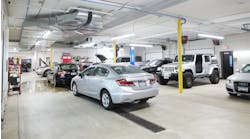When it comes to dealing with customers, Charles Williamson has a simple philosophy: Do whatever it takes to fix the problem.
It’s something that he learned in the restaurant industry before joining the five-location, Texas-based Paceline Collision Centers as the vice president of customer services nine years ago.
“It’s no different than in restaurants: Our goal is to look after the customer and make sure their experience is as good as it can be,” he says. “We have to cut out the little things that affect that.”
Having that “whatever-it-takes” mentality, Williamson says, isn’t just about reacting to situations, though. Processes, procedures and systems are the keys to managing customer-staff interactions and ensuring your business’s ability to give consistent and quality customer service.
And there’s no segment of the repair process more dependent on how your staff interacts with customers than vehicle delivery. Creating a delivery procedure that will leave customers satisfied and employees empowered is critical to improving CSI scores and building a loyal customer base and sound reputation.
The Process
Every opportunity to interact with a customer is important, says Steve Trapp, collision services development manager for Axalta Coating Systems. The delivery process is just a portion of that, albeit a very crucial portion.
—Steve Trapp, Axalta Performance coatings
“It’s the last time you interact with a customer face-to-face in the repair process,” he says. “And it’s the last time you get the chance to really ‘wow’ that customer.”
For Williamson, he’s seen Paceline grow from a one-shop business to a five-facility chain. For any shop, growth makes it more and more difficult to ensure the quality of customer service given by each employee. The only way to do it, Trapp and Williamson agree, is to hire well, and implement thorough standard operating procedures.
Although very specific, the SOP Trapp recommends for all his clients is a simple, six-step process, one that’s helped Williamson and Paceline average above 9.7 points in nearly every customer service-related category of the company’s 10-point CSI survey.
STEP 1
Pre-Closing Preparation
The delivery process does not start when the customer arrives to pick up the vehicle, Trapp says.
“The key to the whole thing, as we see it, is in pre-closing,” he says. “You need to be absolutely ready for that customer to come in.”
You need to know every aspect of the repair—what the issues were and what your staff did to remedy them—and have all the necessary paperwork broken down into a single, organized and clean file.
“You should know exactly what signatures you still need from them, what money you’re owed—whether that’s from the insurer or from them directly,” Trapp says.
Williamson has his staff put the pages still in need of signatures at the top of the pile. Trapp says you can also use sticky notes or other markers where needed.
And make one last note of a “wow factor” from your repair to share with the customer at delivery.
STEP 2
Schedule the Appointment
Part of being prepared for delivery means knowing when the customer will be there to receive the vehicle. Scheduling an appointment is a must, Williamson says, and wait until the paperwork is ready first, in case the customer wants the vehicle immediately.
When setting up the delivery time, inform the customer of what the delivery process will entail, what is required of them (rental car return policies, payments due, warranty information, etc.), and what, if anything, they need to bring with them.
“Having a scheduled time allows you to recognize the customer when they come in,” Trapp says. “It puts your employees at ease knowing who’s coming, and allows them to be fully prepared for the rest of the process.”
STEP 3
Professional Greeting
Interacting with customers is always a balancing act between being as professional as possible and making the interaction comfortable for the person coming into the shop.
Williamson has his staff greet the customer by last name (e.g. “Hello, Mrs. Jones”), and introduces them to all members of the staff that will be assisting with the rest of the process.
“It’s about making sure they understand that you’re there for them,” he says.
Trapp says to also try to relate back to any past conversation to put the customer at ease and show you remember them.
“If you knew they were heading to a soccer match for their kid, ask them how the match went—things like that,” he says.
STEP 4
Vehicle Walk-through
After going through the meet-and-greet, take the customer to their vehicle to review the repair. There’s an important reason to inspect the repair before payment: “It shows the customer that you’re more concerned with the quality of the repair and experience than you are with the payment,” Trapp says.
Williamson wants his staff to go over every aspect of the repair, reminding the customer exactly what was wrong with the vehicle and informing them of exactly what his team did to fix it.
Then, bring up your “wow factor.”
“It needs to be something that wasn’t required in the repair—buffing out a ding on the opposite side of the vehicle, the seam sealer you used, or that you painted the bolts, whatever it was,” Trapp says. “Everyone expects the car to be repaired correctly; they aren’t expecting you to go out of your way to help them out. This is your chance to show them that you did.”
Finish the inspection by giving the customer an opportunity to ask questions, or raise concerns about the repair. Then, if necessary, transport all their items from the rental car to their vehicle for them.
STEP 5
Paperwork, Payment and Surveys
This is the portion that most customers dread, so get the paperwork and payment done quickly. And if Step 1 was completed correctly, that shouldn’t be a problem, Williamson says.
Get the documents signed, the payments made and inform the customer of any warranty or care requirements needed for the vehicle. Then, inform them of your CSI survey process. Paceline uses a 10-point satisfaction system issued by a third-party. Williamson’s staff explains to the customers what the survey will ask and how long it will take.
“They also ask if the customer has any issues with the questions being asked,” Williamson says. “That way, if there is a problem, we can talk them through it before they simply give a poor score. It gives us a chance to explain anything that’s lingering.”
STEP 6
24-Hour Follow-up
Just as the delivery process begins before the customer arrives, it also ends after they leave—24 hours after.
Williamson has his staff call and check on each customer 24 hours after delivery to ensure they are pleased with their vehicle.
“Everything is still fresh in their minds, so it’s a good time to check back in,” he says.
It can be as brief or extensive as the situation dictates, but like any customer interaction, Williamson says to make sure it counts.
“It could be the last time you have a chance to make sure that customer will be a future customer,” he says. “Every customer interaction is so important. You can’t waste any of them. Your staff needs to be prepared, and you have to deliver.”



